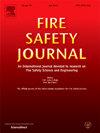Quantitative review of experimental tests and theoretical models of flashover occurrence in compartment fires
IF 3.4
3区 工程技术
Q2 ENGINEERING, CIVIL
引用次数: 0
Abstract
In performance-based fire design (PBFD), flashover is the rapid transition from a growing to a fully developed fire. In this study, a comprehensive literature review and analysis of 93 large-scale compartment fire experiments were conducted to identify the key factors that affect the HRR required for flashover (QFO). For each fire test, key parameters were documented, including fuel load, fuel type, compartment configuration, ventilation properties, boundary characteristics, and the heat release rate (HRR)-time curve. The impact of each parameter on QFO was assessed through comparison with experimental data. It was shown that there are direct correlations between these parameters and QFO. Moreover, available analytical models to predict QFO were compared against the compiled experimental results. Based on experimental data, an equation was proposed to estimate QFO by considering the effect of fuel load, opening factor, boundary characteristics, and compartment shape. These parameters, not previously used all together in other models, resulted in improved accuracy, with the proposed model achieving a mean squared error (MSE) of 0.46 and an R2 value of 86 %, outperforming other theoretical models. The average time to flashover onset, calculated using the proposed equation based on 8800 different scenarios of the same compartment as a case study, varies from 1 min for an ultra-fast fire to 11 min for a slow-growing fire, indicating the need for a fire safety strategy that accounts for different parameters influencing flashover.
舱室火灾中闪络发生的实验试验和理论模型的定量综述
在基于性能的火灾设计(PBFD)中,闪络是火灾从生长到充分发展的快速过渡。本研究通过对93个大型隔间火灾实验的文献综述和分析,找出影响闪络所需HRR (QFO)的关键因素。对于每次火灾测试,记录了关键参数,包括燃料负载,燃料类型,隔间配置,通风性能,边界特性和热释放率(HRR)时间曲线。通过与实验数据的比较,评估各参数对QFO的影响。结果表明,这些参数与QFO之间存在直接的相关关系。此外,还将现有的QFO预测分析模型与编制的实验结果进行了比较。在实验数据的基础上,提出了考虑燃油负荷、开度因子、边界特性和舱室形状影响的QFO估计方程。这些参数以前没有在其他模型中一起使用,结果提高了精度,所提出的模型实现了均方误差(MSE)为0.46,R2值为86%,优于其他理论模型。根据所提出的公式,以同一隔间的8800种不同情况为例,计算出闪络发生的平均时间,从超高速火灾的1分钟到慢速火灾的11分钟不等,这表明需要考虑影响闪络的不同参数的消防安全策略。
本文章由计算机程序翻译,如有差异,请以英文原文为准。
求助全文
约1分钟内获得全文
求助全文
来源期刊

Fire Safety Journal
工程技术-材料科学:综合
CiteScore
5.70
自引率
9.70%
发文量
153
审稿时长
60 days
期刊介绍:
Fire Safety Journal is the leading publication dealing with all aspects of fire safety engineering. Its scope is purposefully wide, as it is deemed important to encourage papers from all sources within this multidisciplinary subject, thus providing a forum for its further development as a distinct engineering discipline. This is an essential step towards gaining a status equal to that enjoyed by the other engineering disciplines.
 求助内容:
求助内容: 应助结果提醒方式:
应助结果提醒方式:


